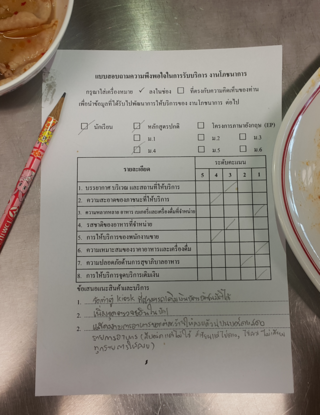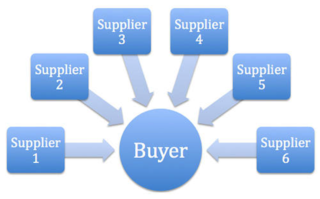Questionnaire construction refers to the design of a questionnaire to gather statistically useful information about a given topic. When properly constructed and responsibly administered, questionnaires can provide valuable data about any given subject.
Survey methodology is "the study of survey methods". As a field of applied statistics concentrating on human-research surveys, survey methodology studies the sampling of individual units from a population and associated techniques of survey data collection, such as questionnaire construction and methods for improving the number and accuracy of responses to surveys. Survey methodology targets instruments or procedures that ask one or more questions that may or may not be answered.
A request for proposal (RFP) is a form of reverse auction that solicits a business proposal by an organisation interested in the procurement of a service or product from potential suppliers. It is usually part of a complex sales process, and made through a bidding process.

Procurement is the process of locating and agreeing to terms and purchasing goods, services, or other works from an external source, often with the use of a tendering or competitive bidding process. The term may also refer to a contractual obligation to "procure", i.e. to "ensure" that something is done. When a government agency buys goods or services through this practice, it is referred to as government procurement or public procurement.

A questionnaire is a research instrument that consists of a set of questions for the purpose of gathering information from respondents through survey or statistical study. A research questionnaire is typically a mix of close-ended questions and open-ended questions. Open-ended, long-term questions offer the respondent the ability to elaborate on their thoughts. The Research questionnaire was developed by the Statistical Society of London in 1838.
Purchasing is the procurement process a business or organization uses to acquire goods or services to accomplish its goals. Although there are several organizations that attempt to set standards in the purchasing process, processes can vary greatly between organizations.
E-procurement is a collective term used to refer to a range of technologies which can be used to automate the internal and external processes associated with procurement, strategic sourcing and purchasing.
Strategic sourcing is the process of developing channels of supply at the lowest total cost, not just the lowest purchase price. It expands upon traditional organisational purchasing activities to embrace all activities within the procurement cycle, from specification to receipt, payment for goods and services to sourcing production lines where the labor market would increase firms' ROI. Strategic sourcing processes aim for continuous improvement and re-evaluation of the purchasing activities of an organisation.
Procurement software refers to a range of business software designed to streamline and automate purchasing processes for businesses and organizations. By managing information flows and transactions between procuring entities, suppliers, and partners, procurement software aims to cut costs, improve efficiency, and boost organizational performance.
Audience Response is a type of interaction associated with the use of Audience Response systems to facilitate interaction between a presenter and their audience.
A request for quotation (RfQ) is a business process in which a company or public entity requests a quote from a supplier for the purchase of specific products or services. RfQ generally means the same thing as Call for bids (CfB) and Invitation for bid (IfB).
Computer-assisted web interviewing (CAWI) is an Internet surveying technique in which the interviewee follows a script provided in a website. The questionnaires are made in a program for creating web interviews. The program allows for the questionnaire to contain pictures, audio and video clips, links to different web pages, etc. The website is able to customize the flow of the questionnaire based on the answers provided, as well as information already known about the participant. It is considered to be a cheaper way of surveying since one doesn't need to use people to hold surveys unlike computer-assisted telephone interviewing. With the increasing use of the Internet, online questionnaires have become a popular way of collecting information. The design of an online questionnaire has a dramatic effect on the quality of data gathered. There are many factors in designing an online questionnaire; guidelines, available question formats, administration, quality and ethic issues should be reviewed. Online questionnaires should be seen as a sub-set of a wider-range of online research methods.
A vendor management system (VMS) is an Internet-enabled, often Web-based application that acts as a mechanism for business to manage and procure staffing services – temporary, and, in some cases, permanent placement services – as well as outside contract or contingent labor. Typical features of a VMS application include order distribution, consolidated billing and significant enhancements in reporting capability that outperforms manual systems and processes.
Supplier evaluation and supplier appraisal are terms used in business and refer to the processes of evaluating and approving potential suppliers by quantitative assessment. The aim of the process is to ensure a portfolio of best-in-class suppliers is available for use. Supplier evaluation can also be applied to current suppliers in order to measure and monitor their performance for the purposes of ensuring contract compliance, reducing costs, mitigating risk and driving continuous improvement.

In a supply chain, a vendor, supplier, provider or a seller, is an enterprise that contributes goods or services. Generally, a supply chain vendor manufactures inventory/stock items and sells them to the next link in the chain. Today, these terms refer to a supplier of any goods or service. In property sales, the vendor is the name given to the seller of the property.
A tender notification is the publication and circulation of procurement opportunities by the procuring entity in various media like: Newspapers, purchasers's own website and government tender bulletin etc. The main objective of wider publicity is to make these opportunities available to a wider supplier community, increase the competition and thus making the procurement process efficient and transparent. In pre-internet era the tenders were published only in the print media but the internet has made it possible to publish the tenders online and make these opportunities available to suppliers globally, on a click of mouse. Though some countries have moved completely to online publication of tender notification, but still there are many countries which are publishing tenders in print media as well. It depends upon the commitment and preparedness of the leadership to make the public procurement efficient and corruption free. The World Bank started bench-marking economies on the basis of legal and regulatory system, which can affect the ability of the suppliers to participate in public procurement process. The latest report from The World Bank - Bench-marking Public Procurement, 2017 assesses 180 economies around the world.

A reverse auction is a type of auction in which the traditional roles of buyer and seller are reversed. Thus, there is one buyer and many potential sellers. In an ordinary auction also known as a forward auction, buyers compete to obtain goods or services by offering increasingly higher prices. In contrast, in a reverse auction, the sellers compete to obtain business from the buyer and prices will typically decrease as the sellers underbid each other.
Cultural consensus theory is an approach to information pooling which supports a framework for the measurement and evaluation of beliefs as cultural; shared to some extent by a group of individuals. Cultural consensus models guide the aggregation of responses from individuals to estimate (1) the culturally appropriate answers to a series of related questions and (2) individual competence in answering those questions. The theory is applicable when there is sufficient agreement across people to assume that a single set of answers exists. The agreement between pairs of individuals is used to estimate individual cultural competence. Answers are estimated by weighting responses of individuals by their competence and then combining responses.
With the application of probability sampling in the 1930s, surveys became a standard tool for empirical research in social sciences, marketing, and official statistics. The methods involved in survey data collection are any of a number of ways in which data can be collected for a statistical survey. These are methods that are used to collect information from a sample of individuals in a systematic way. First there was the change from traditional paper-and-pencil interviewing (PAPI) to computer-assisted interviewing (CAI). Now, face-to-face surveys (CAPI), telephone surveys (CATI), and mail surveys are increasingly replaced by web surveys. In addition, remote interviewers could possibly keep the respondent engaged while reducing cost as compared to in-person interviewers.

An invitation to tender is a formal, structured procedure for generating competing offers from different potential suppliers or contractors looking to obtain an award of business activity in works, supply, or service contracts, often from companies who have been previously assessed for suitability by means of a supplier questionnaire (SQ) or pre-qualification questionnaire (PQQ).




